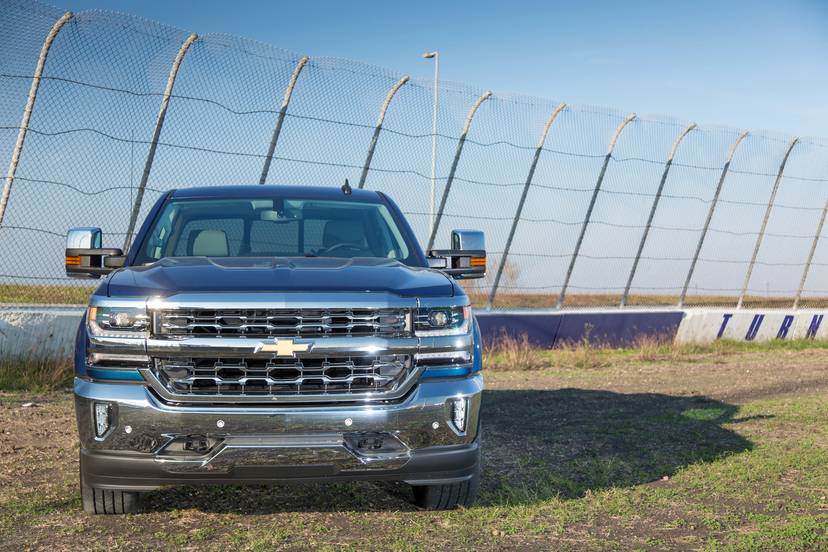
The 2015 Chevrolet Silverado 1500 with its optional 420-horsepower, 6.2-liter V-8 Corvette engine now has its once-missing link for performance: an eight-speed automatic transmission.
The truck we tested — an LTZ crew-cab 4×4 with an optional Z71 Off-Road Suspension Package — won the Cars.com/PickupTrucks.com 2015 Light-Duty V-8 Challenge, which pitted the Chevy against similarly equipped GMC, Ford, Ram and Toyota trucks. It wasn’t the most luxurious truck in our group, but its performance moved it up some notches in this tight class, thanks in part to its new eight-speed, which is paired exclusively with the truck’s biggest engine. The capable 285-hp, 4.3-liter V-6 and 355-hp, 5.3-liter V-8 continue to team up with a six-speed automatic. (See our Silverado’s specs alongside those of the tested GMC, Ford and Ram here and against the Tundra here.)

Exterior & Styling
Chevy offers regular, extended (double cab) and crew-cab models. While the double cab comes only with a 6.6-foot cargo box, the crew and regular cabs each offer a choice of two cargo box lengths, which are tied to the truck’s wheelbase (and thus its overall length). As an alternative to our test Silverado’s 5.75-foot box, the crew cab can also be had with a 6.5-foot box; regular cabs come with 6.6- or 8-foot boxes.
Since their redesign for 2014, the Silverado and its sister GMC Sierra are even closer on the outside: The hoods used to have different grooves but now are almost identical, and the grilles are closing in on a similar size. The new GMC Canyon looks like a downsized Sierra, but the new Chevy Colorado looks more related to older Silverados.
How It Drives
Acceleration, empty or loaded, is the Silverado’s best feature with the 6.2-liter engine. Besides having two more gears for 2015, its transmission’s mapping feels better, with closer gear spacing and the ability to hold gears in the 420-hp engine’s power band for upshifts. Last year’s six-speed would drop below peak torque rpm when shifting — wide-open throttle, uphill with a trailer. When empty, our 2015 Silverado essentially tied for first place in the Challenge with a zero-to-60-mph time of 5.92 seconds (0.01 second behind the Sierra, which was almost identically equipped). The Ram 1500 and Ford F-150 trailed at 6.68 and 6.78 seconds, respectively. The Toyota Tundra TRD Pro brought up the rear at 7.05 seconds.
With 1,240 pounds of payload, the rankings were technically the same: This time the Sierra required just 6.94 seconds to get to 60 mph, the Silverado 7.09, the Ram 7.72, the Ford 8.08 and the Toyota 8.34 seconds.

The Silverado’s braking was the best of the half-ton trucks in the Challenge, loaded or empty: It braked from 60-to-zero mph in 133.7 feet empty and 132.2 feet with 1,240 pounds added to the bed. This loaded stopping distance is as good as it gets with a pickup truck.
The GM trucks and the Ford F-150 had the best ride of the group. It was surprising that the Ram 1500 with four-corner air ride didn’t feel smoother than the 85-year-old Hotchkis leaf-spring design on the Silverado.
The Silverado we tested weighed 500 pounds more than the aluminum-body 2015 Ford F-150. Handling with electric-assist power rack-and-pinion steering is tight, and the wishbone-style front suspension takes curves without effort. GM’s version of electronic stability control, labeled StabiliTrak, helps an empty “light on the rear” truck handle more like a car.
Gas mileage over a mix of city, highway and mountain driving was another place where the 6.2-liter V-8 and eight-speed automatic shined. It led the group with 19.8 mpg when empty, followed by the GMC at 19.6 mpg and the Ford at 17.3 mpg. When towing 6,700 pounds of trailer, though, the Silverado dropped to second place with 10.2 mpg, behind the Ford’s 11 mpg. The GMC’s observed mileage was close when towing, at 10 mpg.
Interior
The dual-density memory foam in the Silverado’s seats made them the most comfortable GM seats I’ve tried, ever. The Silverado has a spotter mirror only on the left, though, even though its largest blind spot — with small cars in the right lane and turning corners — is on the right side. The F-150 has spotter mirrors on both sides. The Silverado also had the smallest windshield of any truck in the Challenge.

The GM trucks have the longest-stroke telescoping steering wheel, which improves comfort, but the steering wheel doesn’t center with your body; it’s off to the right by an inch. This probably goes back to before there was a tilt wheel. The steering wheel also angles slightly toward the driver’s door. All the other truck brands align the seat and dash with the steering wheel instead of changing all the reach angles. To the left of the Silverado’s steering wheel, a 4×4 knob selector and light switch are too close and identical in size, which makes mistakes possible.
Typical of the difference between GMCs and Chevys, the GMC Sierra does have a more upscale interior, with more metal in the dash and doors, plus different screens than the Silverado.
Ergonomics & Electronics
Connectivity has been a common theme at GM the past couple years, and now USB ports and power outlets in the Silverado’s center console make it an ideal mobile office for laptops, tablets and phones. Five USB ports, four 12-volt outlets, an SD data card slot and a 110-volt outlet will keep you and your passengers connected. New for this year is a 4G LTE Wi-Fi internet hot spot, available through an OnStar subscription.
Cargo & Towing
The new, smooth eight-speed transmission dramatically improves towing. The engine no longer lugs between upshifts, holding higher engine rpm and offering more power for towing trailers with traffic rather than in the semitruck lane. This engine and transmission combination we tested can tow 12,000 pounds at speed limits and passing speeds. Payload is 1,580 pounds — respectable for Class I trucks.

The Silverado, along with the GMC, has the most horsepower (420 hp) and torque (460 pounds-feet) in its class and is at home with a trailer on mountain grades. Again with 1,240 pounds of payload, the Silverado had the shortest 60-to-zero-mph stopping distance of the five trucks in the Challenge (133.7 feet empty and 132.2 feet loaded). Though similarly equipped, the GMC needed 138.9 and 148.7 feet, respectively. The longest braking distances came from Toyota’s Tundra TRD Pro (159.6/157.8 feet), likely because it was equipped with off-road tires and a raised ride height.
The Silverado’s downhill grade-shifting frequency in tow mode came in second after the Ford F-150. The Silverado’s trailer brake controller is reachable and now more visible, since Chevy moved it up on the left panel behind the steering wheel, but it’s still on the wrong side for fast manual brake control. GM is the last holdout for having the brake controller on the left side; you won’t find a semitruck with the manual trailer controller on the left side. (GM only held out 30 years with its side terminal batteries, thinking the rest would follow, before giving up on it in 2007.)
Safety
In National Highway Traffic Safety Administration testing, the Chevy Silverado 1500 Crew Cab earned five stars in all categories except the rollover rating, where it earned four, which is the most you can expect from a pickup. Full results are here.
The Silverado’s optional lane departure warning, with alerts in the form of a vibrating seat and dash lights, helped me when driving interstates in Wyoming and other big, open states. (It’s amazing how much daydreaming and swerving happens when towns are 100 miles apart.) Ford’s new lane departure warning system available on the F-150 worries me when the truck automatically steers me back to my lane; it reminds me of Hal’s computer friend in “2001: A Space Odyssey.” For now, the optional Chevrolet Driver Alert Package brings only the warning, not the correction, and also includes forward collision warning and front and rear parking sensors. A backup camera was included in our LTZ and is optional in some lower trim levels.
Value in Its Class
Though the Silverado Z71 LTZ doesn’t feel as luxurious as the Ram Longhorn, it has what you use the most in the cabin. Its power, braking, comfortable seats, quiet cab and towing ability make the Silverado a top value pick for 2015.















































